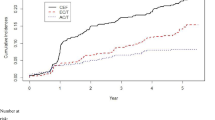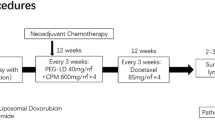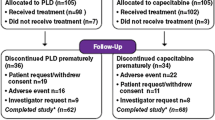Abstract
The purpose of this study was to determine the maximal tolerble dose (MTD) of epirubicin and ADR-529 given in combination with cyclophophamide, 5-fluorouracil, and tamoxifen. A total of 64 breast cancer patients with locally advanced disease or a first metastatic event were included. Using fixed doses of cyclophosphamide, 5-fluorouracil, and tamoxifen, cohorts of ten patients were treated with escalating doses of epirubicin and ADR-529. With the use of protocol criteria specifying evaluation after the first course, the MTD was not reached. Dose reductions carried out due to hematologic toxicity during the first four courses made it impossible to escalate doses of epirubicin beyond 80 mg/m2 given together with ADR-529 600 mg/m2. The vascular toxicity of ADR-529 necessitated central venous access in a number of patients. For phase III evaluation of ADR-529 given together with cyclophosphamide, epirubicin, 5-fluorouracil, and tamoxifen (CEF/TAM) we recommend using epirubicin/ADR-529 at 60/600 mg/m2. Together with evaluation of the cardioprotective properties of ADR-529, we recommend evaluating the impact of ADR-529 on the efficacy of cytotoxic therapy and investigating further the toxicity of ADR-529.
Similar content being viewed by others
References
Doroshow JH, Akman S, Chu FF, Esworthy S (1990) Role of the glutathione-glutathione peroxidase cycle in the cytotoxicity of the anticancer quinones. Pharmacol Ther 47: 359–370
Doroshow JH, Locker GY, Baldinger J, Myers CE (1979) The effect of doxorubicin on hepatic and cardiac glutathione. Rec Commun Chem Pathol Pharmacol 26: 285–295
Creighton AM, Hellmann H, Whitecross S (1969) Antitumor activity in a series of bisdiketopiperazines. Nature 222: 384–385
Hassinoff BB (1989) The interaction of the cardioprotective agent ICRF-187, its hydrolysis products (ICRF-198) and other chelating agents with Fe(III) complexes of adriamycin. Agents Actions 26: 378–395
Harris RN, Doroshow JH (1985) Effect of doxorubicin-enhanced hydrogen peroxide and hydroxyl radical formation on calcium sequestration by cardiac sarcoplasmic reticulum. Biochem Biophys Res Commun 13: 739–745
Agen C, Bernardini N, Danesi R, Torre PD, Costa M, Del Tacca M (1992) Reducing doxorubicin cardiotoxicity in the rat using deferred treatment with ADR-529. Cancer Chemother Pharmacol 30: 95–99
Dardir MD, Herman EH, Ferrans VJ (1989) Effects of ICRF-187 on the cardiac and renal toxicity of epirubicin in spontaneously hypertensive rats. Cancer Chemother Pharmacol 23: 269–275
Herman EH, El-Hage A, Ferrans VJ (1988) Protective effect of ICRF-187 on doxorubicin-induced cardiac and renal toxicity in spontaneously hypertensive and normotensive rats. Toxicol Appl Pharmacol 92: 42–53
Herman EH, Ferrans VJ (1983) Influence of vitamin E and ICRF-187 on chronic doxorubicin cardiotoxicity in miniature swine. Lab Invest 49: 69–77
Herman EH, Ferrans VJ (1981) Reduction of chronic doxorubicin cardiotoxicity in dogs by pretreatment with (+/−)-1,2-bis(3,5-dioxopiperazinyl-1-yl)-propane (ICRF-187). Cancer Res 41: 3436–3440
Herman EH, Ferrans VJ, Myers CE, Vleet JV van (1985) Comparison of the effectiveness of (+/−)-1,2-bis(3,5-dioxopiperazinyl-1-yl)-propane (ICRF 187) andN-acetylcysteine in preventing chronic doxorubicin cardiotoxicity in beagles. Cancer Res 45: 276–281
Perkins WE, Schroeder RL, Carrano RA, Imondi AR (1982) Effect of ICRF-187 on doxorubicin-induced myocardial effects in the mouse and guinea pig. Br J Cancer 46: 662–667
Alderton PM, Gross J, Green MD (1992) Comparative study of doxorubicin, mitoxantrone, and epirubicin in combination with ICRF-187 (ADR-529) in a chronic cardiotoxicity animal model 1. Cancer Res 52: 194–201
Milliard JA, Speyer JL, Hanson K, Shaikh BS, Chang A, Ryan K (1992) Prevention of chronic Adriamycin cardiotoxicity with the bidiozopiperazine dexrazoxane (ICRF-187, ADR-529, Zinecard) in patients with advanced or metastatic breast cancer (abstract). Proc Am Soc Clin Oncol 11: 91
Rosenfeld CS, Weisberg SR, York RM, Jones SE, Spicer DV, Khojasteh A (1992) Prevention of Adriamycin cardiomyopathy with dexrazoxane (ADR-529, ICRF-187) (abstract). Proc Am Soc Clin Oncol 11: 62
Speyer JL, Green MD, Kramer E, et al. (1988) Protective effect of the bispiperazinedione ICRF-187 against doxorubicin-induced cardiac toxicity in women with advanced breast cancer. N Engl J Med 319: 745–752
Speyer JL, Green MD, Zeleniuch-Jacquotte A, et al. (1992) ICRF-187 permits longer treatment with doxorubicin in women with breast cancer. J Clin Oncol 10: 117–127
Weisberg SR, Rosenfeld CS, York RM, Jones SE, Spicer DV, Khojasteh A (1992) Dexrazoxane (ADR-529, ICRF-187, Zinecard) protects against doxorubicin induced chronic cardiotoxicity (abstract). Proc Am Soc Clin Oncol 11: 91
World Health Organization (1979) Handbook for reporting results of cancer treatment. WHO, Geneva
Hochster HS, Liebes L, Wadler S, et al (1992) Pharmacokinetics of the cardioprotector ADR-529 (ICRF-187) in escalating doses combined with fixed-dose doxorubicin. J Natl Cancer Inst 84: 1725–1730
Leismann J, Belt R, Haas C, Hoogstraten B (1981) Phase I evaluation of ICRF-187 (NSC-169780) in patients with advanced malignancy. Cancer 47: 1959–1962
Brubaker LH, Vogel CL, Einhorn LH, Birch R (1986) Treatment of advanced adenocarcinoma of the kidney with ICRF-187: a Southeastern Cancer Study Group trial. Cancer Treat Rep 70: 915–916
Basser R, Duggan G, Rosenthal M, Sheridan W, Fox R, Mihaly G (1992) Optimal dose ratio of ADR-529 (ICRF-187) and epirubicin (abstract). Proc Am Soc Clin Oncol 11: 123
Pedersen-Bjergaard J, Philip P, Larsen SO, Jensen G, Byrsting K (1990) Chromosome aberrations and prognostic factors in therapy-related myelodysplasia and acute nonlymphocytic leukemia. Blood 76: 1083–1091
Tanabe K, Ikegami Y, Ishida R, Andoh T (1991) Inhibition of topoisomerase II by antitumor agent bis-(2,6-dioxopiperazine) derivatives. Cancer Res 51: 4903
Pedersen-Bjergaard J (1992) The dioxopiperazine derivatives, their leukemogenic potential and other biological effects. Leuk Res 16: 1057–1059
Ejlertsen B, Pfeiffer P, Pedersen D, et al (1993) Decreased efficacy of cyclophosphamide, epirubicin and 5-fluorouracil in metastatic breast cancer when reducing treatment duration from 18 to 6 months. Eur J Cancer 29A: 527–531
Bokkel Huiniuk WW ten, Schreuder JE, Dubbleman R, et al (1992) ICRF 187 protects against doxorubicin induced cardiomyopathy. Ann Oncol 3 [Suppl 3]: 114
Narang PK, Hochster HS, Reynolds RD, et al (1992) Does the cardioprotectant dexrazoxane (DZR) affect doxorubicin (DOX) kinetics/dynamics (abstract)? Proc Am Soc Clin Oncol 11: 126
Sehested M, Jensen PB, Sørensen BS, Holm B, Friche E, Demant EJF (1993) Antagonistic effect of the cardioprotector (+)-1,2-bis(3,4-dioxopiperazinyl-1-yl)propane (ICRF-187) on DNA breaks and cytotoxicity induced by the topoisomerase II directed drugs daunorubicin and etoposide (VP-16). Biochem Pharmacol 46: 389–393
Author information
Authors and Affiliations
Rights and permissions
About this article
Cite this article
Sørensen, B., Bastholt, L., Mirza, M.R. et al. The cardioprotector ADR-529 and high-dose epirubicin given in combination with cyclophosphamide, 5-fluorouracil, and tamoxifen: a phase I study in metastatic breast cancer. Cancer Chemother. Pharmacol. 34, 439–443 (1994). https://doi.org/10.1007/BF00685571
Received:
Accepted:
Issue Date:
DOI: https://doi.org/10.1007/BF00685571




